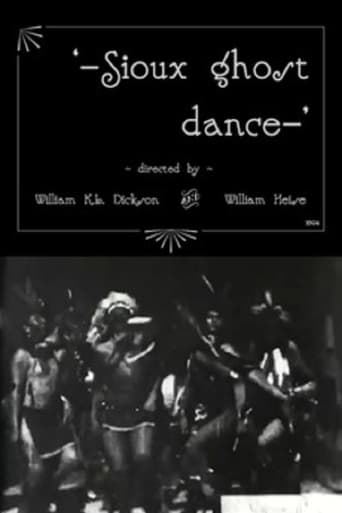kobe1413
The world's first filmmakers William Heise and W.K.L. Dickson film members of Buffalo Bill Cody's traveling performers. These Native-Americans do a small portion of what is supposed to be a Sioux Ghost Dance.The group is crowded on stage, with both children and adults doing the dance. There is no word as whether this is an authentic dance from actual Sioux culture or if it is an invention by Cody to fill seats at his shows. Not much is actually shown in the short clip, but it is the first known representation of Native-Americans, real or otherwise, in cinema, so it is noteworthy for that alone.
Horst in Translation ([email protected])
I'd say the title is exactly what you see in this 20-second-long short movie, but I wasn't really sure where the "ghost" reference was. Maybe the way they were moving? It was actually rather boring and not too artistic and certainly didn't seem too supernatural or spooky to me to be honest and if you asked them, they might even agree. It's still an okay film for the beautiful dresses and especially hair-dresses these Indians were wearing. As a whole, though, I'd really only recommend it to silent film enthusiasts. Everybody else can do very well without this experience. The physical quality of the film is not great either, even for 1894. Dickson and Heise have delivered some more impressive works even in the same year.
José Luis Rivera Mendoza (jluis1984)
1894 was an extremely important year for American cinema, as finally after 5 years of hard work, the Edison Manufacturing Company showed to the world the first motion picture exhibition device: William K.L. Dickson's Kinetoscope. It wasn't anything like what we now know as cinema (it wasn't a projector), but it was the first device that allowed people to be able to contemplate moving images. Soon the first public Kinetoscope parlor was opened and motion pictures started to become part of our world, opening the way to new pioneers like the Lumière brothers, inventors of cinema as we know it, who found a lot of inspiration for their work in Dickson's invention. When the Kinetoscope debuted, it offered short films depicting vaudeville artists, common activities like horse shoeing or metal forging, and some sports; but soon everyone wanted to be captured by the camera and among those first movie stars were the members of the "Buffalo Bill's Wild West" show.According to historians, on September 24, 1894, several members of Buffalo Bill's Wild West show arrived to Edison's famous Black Maria studio in order to perform in front of the camera and be part of the motion pictures revolution. Among the films done that day by Dickson and cinematographer William Heise, were two short films about Native American dances, which are considered as the very first movies where Native Americans appeared. "Sioux Ghost Dance" and "Buffalo Dance" were those two films, and both showed a group of Native Americans performing a song. In "Sioux Ghost Dance", a group of Sioux people make the ritual dance inspired by prophet Jack Wilson's (known as Wovoka) religious teachings. Sadly, due to the limitations of Dickson's early camera-work the magnitude of the Ghost dance can not be fully appreciated.While a product of the late 1800s, the Ghost Dance was based on the traditional circle dances that Native Americans had been performing for centuries, so "Sioux Ghost Dance" (and its companion piece, "Buffalo Dance") allowed to Kinetoscope's audiences a small look at real Native American traditions. Despite being a show were the actors reenacted scenes from the wild west, "Buffalo Bill's Wild West" had many extremely accurate and realistic elements, and the Native dances were one of them, proudly portraying their traditions under the protection of Buffalo Bill Cody (who was very respectful of them). It's true that without the sound, the dance loses a lot of its impact, but this movie is still an early example of documentary film. 6/10
Snow Leopard
While much of the print of this feature has deteriorated badly, and while the footage itself may strike many present-day viewers as simply emphasizing stereotyped portrayals of Native Americans, it is still of some interest as an example of early studio practices. It was one of a number of features that the Edison Company filmed at around the same time using performers from the Buffalo Bill Wild West exhibition, but this one in particular was made not for domestic viewing, but rather for European distribution.The Edison Company was always on the lookout for money-making and money-saving ideas, and many of their early features were financed by potential distributors, at little or no cost to Edison. According to film historian Charles Musser (in an interview accompanying Kino's DVD collection of Edison films), this particular movie was one such example, having been made as part of promoting the Wild West's upcoming tour of Europe.The footage itself is not especially impressive, in large part because of damage done to the film over time. It does apparently use genuine members of the Sioux tribe, and in viewing it, it should also be remembered that the constraints of filming inside the Edison Company's 'Black Maria' studio almost certainly hindered the dancers' ability to do the dance on its usual scale. As a result, they seem to be unnaturally scrunched together for most of the running time.In any case, the fascination with the 'wild west', its myths, and its figures seems to have been at least as strong in Europe as it was in the USA, and this brief movie is one illustration of that. It is also one of many illustrations of the competitive business practices of the earliest film-makers - there seems never to have been a time when movie-making was not a serious business to some.

